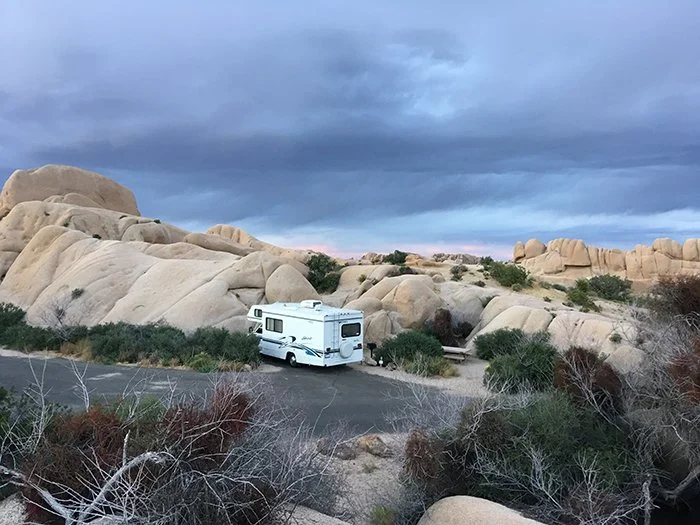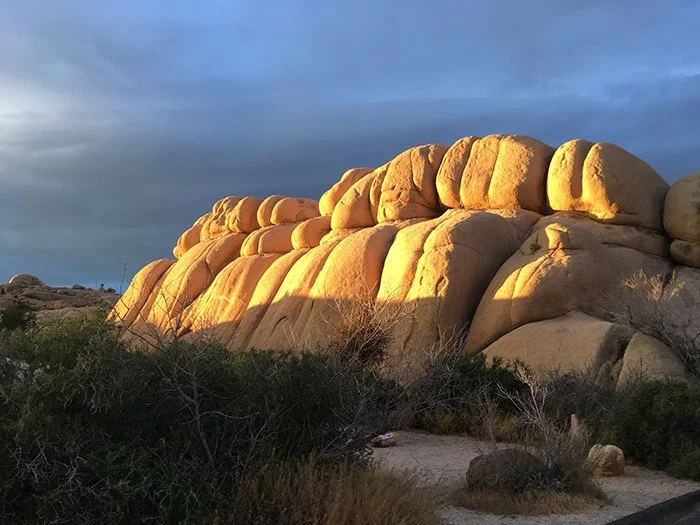Jumbo Rocks Campground
For many years, my husband Garth and I have traveled the western states in our little 24-foot motorhome, along with our golden retriever Chase (and occasionally our cat!). In this and subsequent RVCYOB articles, I’ll share with you our experiences, our opinions on the best campsites to reserve, clever camping gear and gizmos, tried-and-true hacks, secret hikes, camp recipes, camping with pets and kids, things to avoid, and things you won’t want to miss. I hope you’ll enjoy traveling with us.
We’ve been to a lot of spectacular places. But we had never experienced a place like Jumbo Rocks.
Driving into Jumbo Rocks Campground at sunset was like entering a prehistoric desert world just in time for the cosmic light show. An intense orange light illuminated massive sculpted boulders against a dark backdrop of twilight sky. We quickly parked our little motorhome at our site—one of many tucked among these movie-set rocks—then we clambered to the top to watch the rest of the show.
There’s a reason why Jumbo Rocks is the most coveted of the eight campgrounds in Joshua Tree National Park. It’s downright magical. Other worldly. A Triceratops could emerge from behind that boulder, or the crew of the Enterprise could beam down right in front of you.
This was Stop #1 on our month-long Circle of the Southwest in April. It immediately set the tone for what was to become one of our all-time favorite trips—where each day brought experiences as fantastical as the day before—Bryce, Zion, Arches, Grand Canyon... It was a trip that deeply impressed us. We felt both exhilarated and overwhelmed by the striking grandeur of Mother Nature’s geological artwork. From the artificial shelter of our motorhome, we witnessed the harsh demands she extracts from her desert creatures and plants, but also the unique rewards found only here: red flowering torches of Ocotillo, twisted sculptures of ancient Joshua trees, blue-black night skies glittered with more stars than you’ve ever seen, and the serene desert silence interrupted only by far-off coyote yips. Consider booking your own exploration of some of the most magnificent places on your planet. We suggest April for wildflowers.
Stop #1 – Jumbo Rocks Campground
Jumbo Rocks Campground offers 124 flat, sandy sites—some tucked between gigantic, rounded granite boulders, some at the edge of the desert. Only 63 accommodate RVs. Prepare for that high desert wilderness experience.
· No hookups or dump station. Embrace frugality!
· No cell service. Time to unplug!
· No drinking water. Bring your own!
· Vault toilets only. Clean, non-smelly!
· No showers. Pretend you’re a pioneer!
· No shade. Good for your solar panels! Take a pop-up.
PETS: Leashed dogs allowed in camp and on dirt roads—not on trails. Please don’t leave pets in vehicles that can get HOT.
HIKING: Starting in camp, Skull Rock Nature Trail is an easy, family-friendly 1.7 mile loop through flowering desert, boulder fields, and rock canyons. Nearby tougher hikes: Split Rock and Ryan Mountain.
KIDS’ PLAY: Exploring; climbing boulders; biking around camp; Ranger programs; seeing the Milky Way, satellites, shooting stars; mimicking coyotes.
TAKE CARE: Jumping Cholla, and other armed desert plants, will protect themselves against loose kids and dogs! Bees have been reported in August.
Jumbo Rocks sits at 4,380’. High season is Oct.-May (daytime 70°-90°). Low season is June-Sept., attracting folks who enjoy punishing heat well over 100°. Not this coastal sissy. I like 68°.
Ready to book Jumbo Rocks? I guarantee you’ll never forget it. NOTE: reservations required year-round, made during a 6-month window at www.recreation.gov. Fees just $25/night (2025) plus $30 park entrance fee. Check for fire restrictions. Sites we recommend: 26, 78, 97, 117, 120, and 121 (first choice). For large rigs, try sites 82-94. Check www.campsitephotos.com to see photos.
When you leave, drive east through the park on scenic Pinto Basin Road. Stop to walk the Barker Dam Trail (easy 1.1 mile) to the small historic dam, continuing on to some cool petroglyphs. You’ll see amazing desert wildflowers in April and maybe some bighorn sheep.
Next, stop at the Cholla Cactus Garden for a ¼ mile stroll through the deceiving Jumping Cholla plants that look like fuzzy white teddy bears but beware—they have nasty spines that will “jump” onto/into you! The valley is wall-to-wall Cholla—several feet apart in true desert fashion. They’ve all agreed to share the skimpy rainfall.
Continuing on, stop at the Ocotillo Patch pullout to see one of my now-favorite plants. Talk about desert adaptation! When it’s dry, the Ocotillo loses all its tiny green leaves to resemble a 10’ tall bundle of spiny dead sticks. With rain, it immediately refoliates in green leaves, then tubular red flowers. Hummingbirds go crazy. When rain stops, the cycle repeats—several times per year.
So far, our Circle of the Southwest has showered us with new experiences. On to Stop #2—Frank Lloyd Wright’s Taliesin West.






